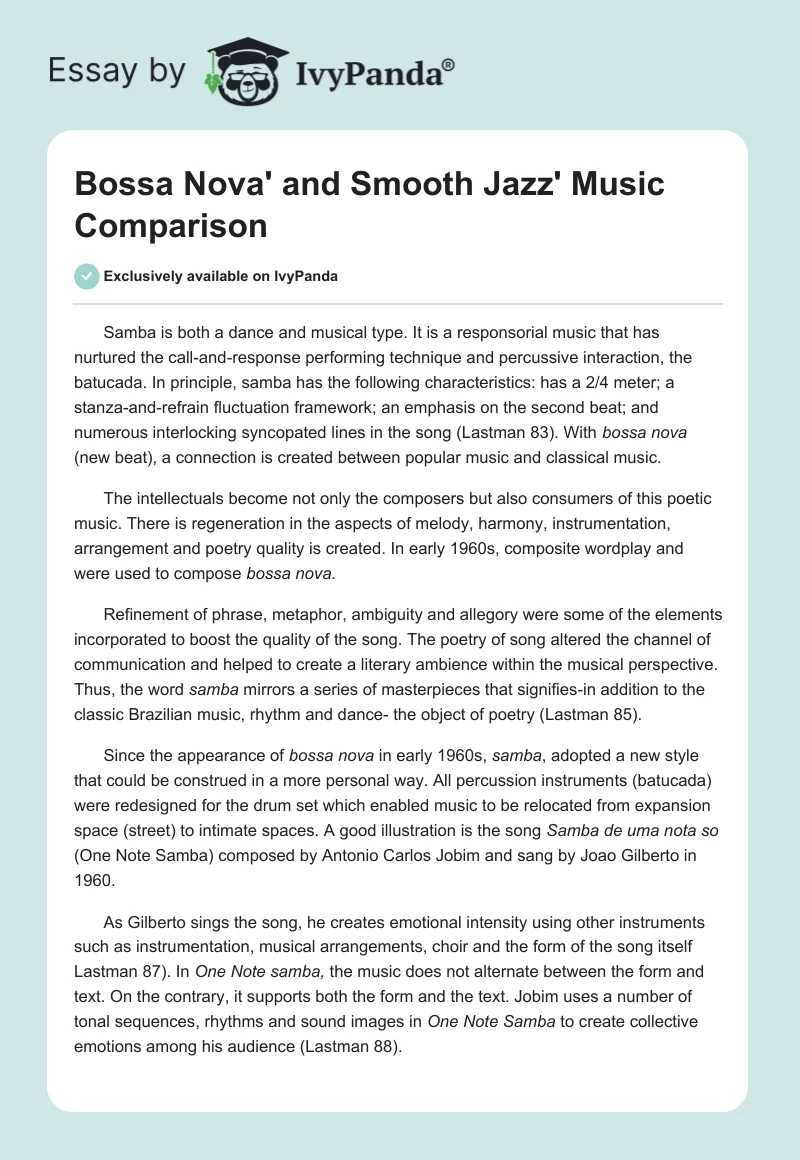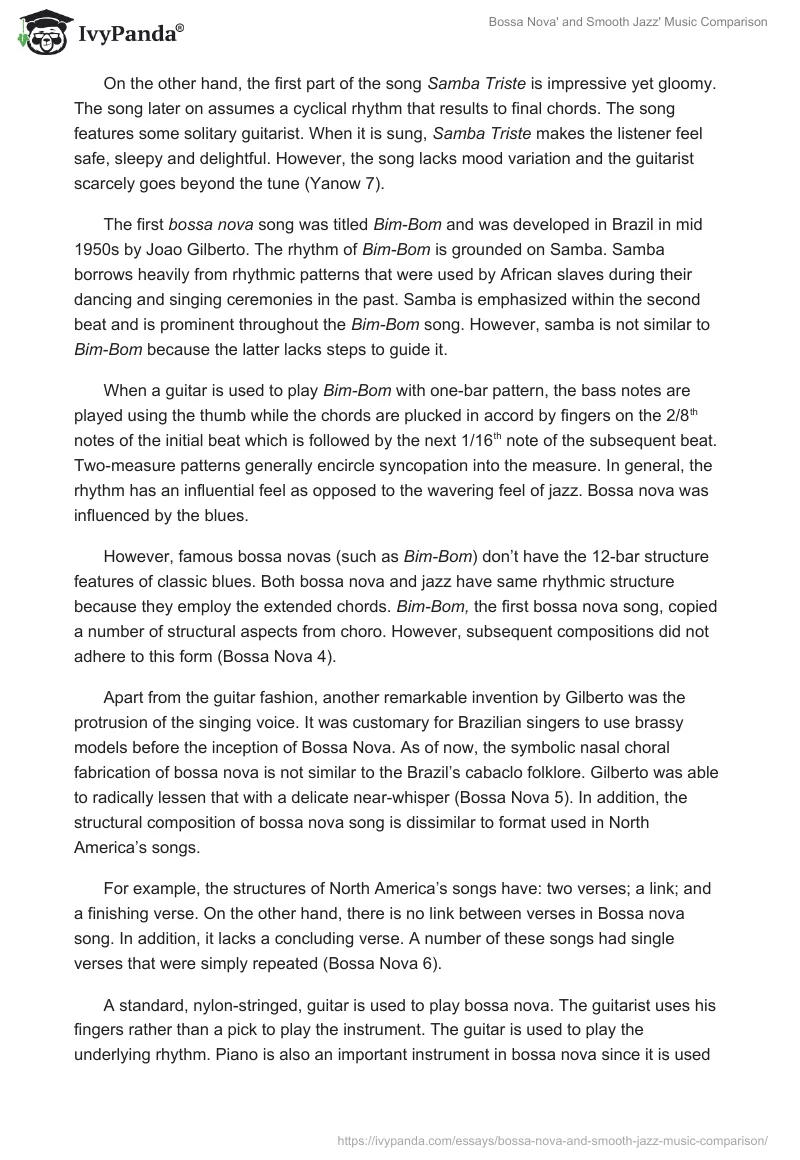Samba is both a dance and musical type. It is a responsorial music that has nurtured the call-and-response performing technique and percussive interaction, the batucada. In principle, samba has the following characteristics: has a 2/4 meter; a stanza-and-refrain fluctuation framework; an emphasis on the second beat; and numerous interlocking syncopated lines in the song (Lastman 83). With bossa nova (new beat), a connection is created between popular music and classical music.
The intellectuals become not only the composers but also consumers of this poetic music. There is regeneration in the aspects of melody, harmony, instrumentation, arrangement and poetry quality is created. In early 1960s, composite wordplay and were used to compose bossa nova.
Refinement of phrase, metaphor, ambiguity and allegory were some of the elements incorporated to boost the quality of the song. The poetry of song altered the channel of communication and helped to create a literary ambience within the musical perspective. Thus, the word samba mirrors a series of masterpieces that signifies-in addition to the classic Brazilian music, rhythm and dance- the object of poetry (Lastman 85).
Since the appearance of bossa nova in early 1960s, samba, adopted a new style that could be construed in a more personal way. All percussion instruments (batucada) were redesigned for the drum set which enabled music to be relocated from expansion space (street) to intimate spaces. A good illustration is the song Samba de uma nota so (One Note Samba) composed by Antonio Carlos Jobim and sang by Joao Gilberto in 1960.
As Gilberto sings the song, he creates emotional intensity using other instruments such as instrumentation, musical arrangements, choir and the form of the song itself Lastman 87). In One Note samba, the music does not alternate between the form and text. On the contrary, it supports both the form and the text. Jobim uses a number of tonal sequences, rhythms and sound images in One Note Samba to create collective emotions among his audience (Lastman 88).
On the other hand, the first part of the song Samba Triste is impressive yet gloomy. The song later on assumes a cyclical rhythm that results to final chords. The song features some solitary guitarist. When it is sung, Samba Triste makes the listener feel safe, sleepy and delightful. However, the song lacks mood variation and the guitarist scarcely goes beyond the tune (Yanow 7).
The first bossa nova song was titled Bim-Bom and was developed in Brazil in mid 1950s by Joao Gilberto. The rhythm of Bim-Bom is grounded on Samba. Samba borrows heavily from rhythmic patterns that were used by African slaves during their dancing and singing ceremonies in the past. Samba is emphasized within the second beat and is prominent throughout the Bim-Bom song. However, samba is not similar to Bim-Bom because the latter lacks steps to guide it.
When a guitar is used to play Bim-Bom with one-bar pattern, the bass notes are played using the thumb while the chords are plucked in accord by fingers on the 2/8th notes of the initial beat which is followed by the next 1/16th note of the subsequent beat. Two-measure patterns generally encircle syncopation into the measure. In general, the rhythm has an influential feel as opposed to the wavering feel of jazz. Bossa nova was influenced by the blues.
However, famous bossa novas (such as Bim-Bom) don’t have the 12-bar structure features of classic blues. Both bossa nova and jazz have same rhythmic structure because they employ the extended chords. Bim-Bom, the first bossa nova song, copied a number of structural aspects from choro. However, subsequent compositions did not adhere to this form (Bossa Nova 4).
Apart from the guitar fashion, another remarkable invention by Gilberto was the protrusion of the singing voice. It was customary for Brazilian singers to use brassy models before the inception of Bossa Nova. As of now, the symbolic nasal choral fabrication of bossa nova is not similar to the Brazil’s cabaclo folklore. Gilberto was able to radically lessen that with a delicate near-whisper (Bossa Nova 5). In addition, the structural composition of bossa nova song is dissimilar to format used in North America’s songs.
For example, the structures of North America’s songs have: two verses; a link; and a finishing verse. On the other hand, there is no link between verses in Bossa nova song. In addition, it lacks a concluding verse. A number of these songs had single verses that were simply repeated (Bossa Nova 6).
A standard, nylon-stringed, guitar is used to play bossa nova. The guitarist uses his fingers rather than a pick to play the instrument. The guitar is used to play the underlying rhythm. Piano is also an important instrument in bossa nova since it is used as a classic bridge between jazz and bossa nova, thereby facilitating extensive cross-pollination between the two genres.
In addition, other instruments such as drums are used although in a limited role it is prominent in a number of Jobim’s and Gilberto’s personal recordings. The exceptional acoustic texture of bossa strings, when employed, is a critical minor attribute of the genre. However, the genuine instruments feature the strings in a unique way. (Bossa Nova 7).
The song Apesar de Voce is composed in D major. The structure of the song has a choral introduction of eight bars. The choir is introduced in harmony and heard as distant in space, getting nearer when the second phrase is sung. The impression of the introduction creates a corporal proximity perception among the listeners. When the sound of the band is closer, the listener becomes part of the liberating ritual. Each section of the music has four stanzas, each with three verses.
With respect to the text, each stanza (lasting eight bars) conveys a unique idea. This implies that each section, with respect to musical (chord and melody progression) and textual (poetry) articulates different ideas in four sentences (Lastman 90). The structure of the song reflects a free game of antithesis that occurs between today and tomorrow.
The lyric self anticipates, from an invincible position of the repressor Voce (You), a steady process that will eventually see the tyrant experience the pain lived Hoje (Today) for those who are against the regime. The song articulates the vision of an aspired future, one that is emphasized by the repetitions of B sections. Tension rises in the context of the text. Instead of using continuous words, the songwriter employs Etcetera e tal in the second stanza of B4 section and ends the other stanzas with the phrase la-la-la.
The link between musical world and poetry world in this song is perceived as the result of the encounter between cult and the popular. The song unveils a perspective of the real state of affairs employing small tonality in contrast to the reality that will materialize (Lastman 94).
The Velvet Underground music is similar to pop music in several ways. A very subdued drum beat and bang guitars were the only instruments used by the Velvet Underground. The Velvet song is so cramped and closed in that it sounds as if it was hurriedly composed. However, its lyrics are quite interesting. The groove of the song is entirely based on a hurriedly played piano which is analogous to I’m waiting For the Man apart from the fact that it is played more rapidly.
In addition, Velvet is sloppier and filled to the brim loud feedback screeches. It is similar to any other boogie-rocker at its core since its bluesy chord sequence is quite familiar. Nonetheless, Lou Reed’s conversational lead chorals are very weird. As he sings, Reed is practically screaming, yelping, talking, and rarely does he observe the key. The guitars are too flailing in an astonishing insane way with its high-pitched distorted noises and it is loudly mixed with the vocals.
However, the song employs a swiftly paced drumbeat to avoid boredom. Velvet also uses a mid-tempo groove that enables the song to last eight minutes. Rather than singing, John Cale narrates a short story in a straitlaced manner. Other than the lyrics, Velvet is the closest song to pop music. It possesses an attractive riff, compelling rhythm, and an easy yet hooky melody. Generally, it is sung messily, the guitars sustain the riff but if they overlook a note, they do not worry much (Lawrence 6)
New Horizon is a gospel music that features several instrumental personalities such as Shaun Johnson and Marquis Hill. The song carries the trademark of having been composed from the bottom up. With regard to tenor sax, Dawkins is not as convincing as he is on alto. However, his solo corresponds to the flexible grace of the accompaniment where the off-beat work by Parker avoids the obvious as though it was a matter of life or death.
Shades of the Prairie Prophet illustrates how the band can overlap apparently contradictory musical frontiers with fewer difficulties. With respect to The New Horizon’s rhythmic rolling, the song has no scarcity of urgency. However, Parker’s accompaniment and Steve Berry’s solo permeate the song with a sense of measured elegance which in inferior hands would possibly lead to the breakdown of the music. Given the caliber of this band, the overall cohesion of this unit mitigates any probable breakdown (Jones 8).
The New Horizon features a blend of young and veteran individuals. Dawkins, who is the main writer and composer, swaps between alto and tenor, next to trombonist Steve Berry. Given the group’s forceful frontline, it combines propulsive hard bop arrogance with polyrhythmic groove into a stimulating blend. Dawkins balances the conventional hard-bop drive of Art Blakely’s Jazz Messengers with the discord and angularity of classic free Jazz, generating a riveting hybrid (Collins 6).
Spencer and Savage lock tight as they modulate tempos and rhythms during many thorny transitions. They increase the fervency of their interaction to thrust the frontline soloists into unanticipated areas. In addition, Brown plays with vigor and confidence as he alternates between cacophonous outbursts and stoic scalar variations. Meanwhile, Dawkins is magnificent and regal on tenor, working lyrical fragments throughout the song. The caustic and fervent character of his alto sax discloses his most assertive skills.
His rasping tone and vociferous declaration brings memories of fellow native Chicagoan’s Roscoe Mitchell and Anthony Braxton. Although Berry is reserved, he is lyrical and creative, exceptional with a plunger mute, particularly on Goin Downtown Blues. Dawkins even tries blues singing and scatting on this song, with a simple dedication to Southside Chicago. The band holds on to their dynamic AACM legacy on The New Horizon with an all inclusive solo from Brown, who practically plays his trumpet backwards.
The song is shot from different viewpoints using numerous cameras, with overlays and cross-fades occasionally employed to transition between shots. Therefore, Ernest Dawkins’ New Horizons sets a standard for emerging ensembles to aim at. The Messenger, an excellent set and expertly composed, expresses how creative jazz practice makes use of the past to enlighten the future (Collins 8).
Works cited
Bossa Nova. Historical Past of Bossa Nova. Web.
Collins, Troy. Ernest Dawkins’ New Horizons Ensemble: Live at the Original Velvet Lounge. 2006. Web.
Jones, Nic. Ernest Dawkins’ New Horizons Ensemble: The Prairie Prophet. 2011. Web.
Lastman, Sabrina. “Revaluation of samba in Chico”. Baroque’s critic song. 1.1 (2006): 82- 97.
Lawrence, Michael. The Velvet Underground. Web.
Yanow, Scott. Flabbergasted Vibes. 2011. Web.


